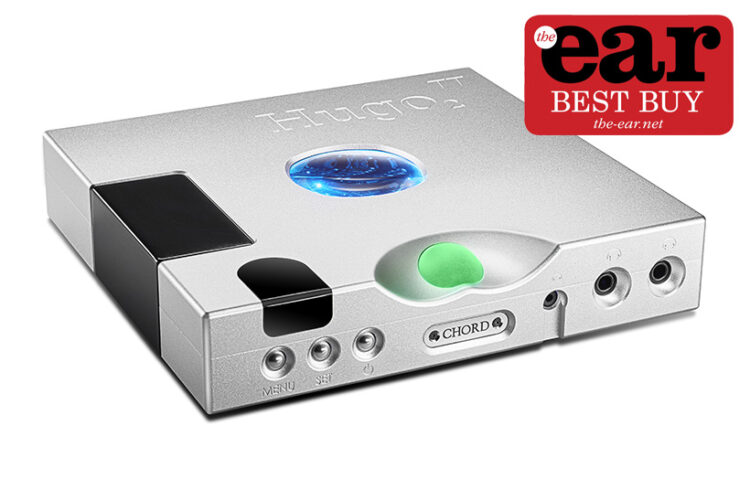Hugo TT 2 is Chord Electronics’ next-generation table-top (TT) DAC/headphone amplifier, the 2 indicating it that has undergone extensive upgrades to bring it within touching distance of the company’s flagship DAVE DAC at a fraction of the price. The £3,995 TT 2 advances the original Hugo TT in several areas. Available in silver or black, the exquisitely contoured 235mm square aluminium ‘clamshell’ casework has been redesigned to provide enhanced functionality. Three front panel buttons (‘Menu’, ‘Set, ‘Power’) now turn the unit on/off, cycle inputs and activate the filtering and crossfeed modes. The backlit, spherical volume roller is in a more accessible location and has grown in size, as has the viewing window to the internal circuits.
The legibility of the dot-matrix display panel for input, sampling rate and volume is improved too, but as this is designed to time-out after a ten second period for optimal audio performance, the volume and sampling rates are also represented in polychrome. The colour of the roller ball gradually changes as the volume is raised or lowered and the sampling rate is indicated by one of eleven colours in the LED-illuminated viewing window, a rather clever and effective means of providing instant visual feedback (assuming you’ve taken the time to learn the polychromatic scale, of course!). The remote control has been streamlined and simplified but can still be used to control all of TT 2’s features apart from gain, which must be changed via the push buttons on the unit itself.
DAC architecture
Chord DACs are acclaimed for superior perceived timing, much of which is attributed to their use of custom-coded FGPA chips and patented Watts Transient Aligned (WTA) algorithms in preference to ‘off-the-shelf’ pre-programmed delta-sigma DAC chips. Hugo TT 2 uses a new Artix 7 FGPA chip with a ten element digital filter that has almost quadrupled the 26,000 taps provided by the previous four element filter to 98,000 taps, meaning TT 2 has “five times the processing power of the original Hugo TT”. A revised 16FS oversampling WTA algorithm ensures this additional processing power is harnessed to best effect.
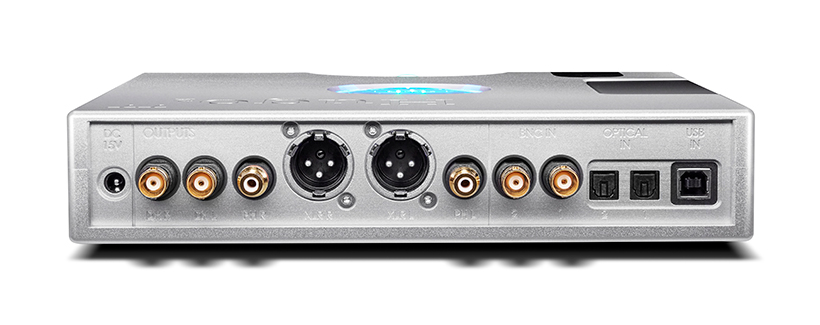
The filter tap length is a fundamental aspect of the WTA approach (see below) to digital-to-analogue conversion as it contributes to the accuracy of the interpolation. Put simply, the greater the number of taps, the greater the accuracy at which the original analogue waveform can be reconstructed. Hugo TT 2’s sizeable tap upgrade pushes it closer to DAVE’s 164,000 taps than any other DAC in Chord’s current lineup, a position previously held by the portable Hugo 2 with its 49,000 taps. In addition to significantly improved interpolation accuracy, TT 2 supports maximum input sampling rates of PCM 768kHz and DSD 512, double those of its predecessor.
Capacities
More than just a headphone amplifier, Hugo TT 2 can also be used as a dedicated DAC into an external preamplifier or as a combined DAC/preamp into an external power amplifier or active speakers. Selecting ‘DAC’ or ‘AMP’ mode in Hugo’s menu instructs either a fixed 2.5Vrms (single-ended) / 5Vrms (balanced) or a variable voltage to be sent to the analogue outputs. Most modern preamps should cope fine with a 2.5Vrms input, but for those that perform more optimally with a lower input, Hugo TT 2 can be used in ‘AMP’ mode with its variable output adjusted to match the external preamp’s preferred input level to very good effect. Hugo’s output voltage is controlled digitally and is exceptionallytransparent; in listening tests I detected no appreciable differences between its ’DAC’ and ’AMP’ operating modes.
On the front of the unit are three headphone outputs (two 6.3mm and one 3.5mm), plugging ‘phones into these automatically mutes the stereo RCA and XLR analogue outputs located at the rear. There are also two digital coax BNC outputs labelled ‘DX’, rumoured to be for future Chord digital power amps.
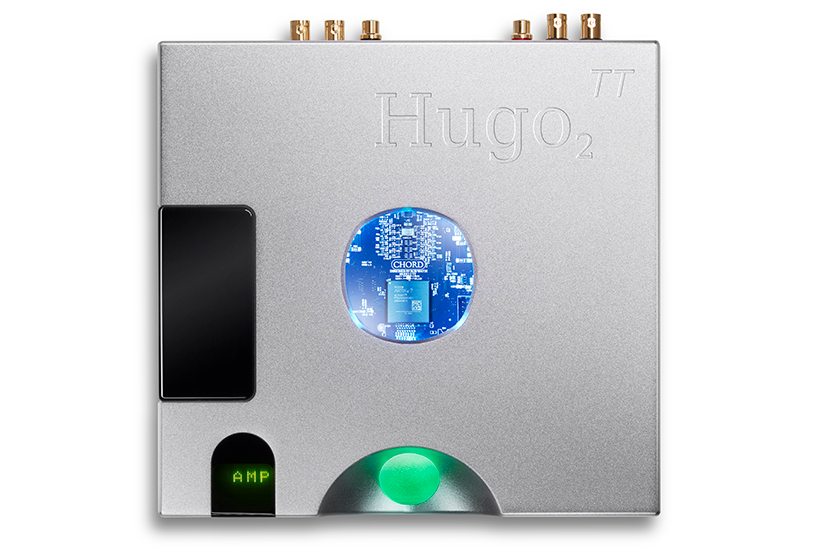
TT 2’s inputs include galvanically isolated USB, optical Toslink (x2), BNC coax (x2) and Bluetooth aptX. The BNCs can be used as individual coax inputs or ‘dualled’ to the BNC outputs of Chord’s Blu Mk2 CD transport or Hugo M Scaler to benefit from the maximum bandwidth from Rob Watts’ groundbreaking million-tap upscaling device. My listening impressions were formed using the USB input with a Mac Mini configured to output audio at its native sampling rate, thus giving TT 2 full opportunity to demonstrate its oversampling abilities. I briefly tested Bluetooth performance using an iPod Touch (6th generation) and was by comparison underwhelmed, though I suspect this is at least partly due to Apple’s continued lack of aptX support.
Power
Another notable design change means Hugo TT 2 is no longer battery powered , this has been replaced by an internal bank of six super-capacitors powered by an external 15V 4A DC supply. The super-capacitors charge in a similar way to a battery and, according to the designer, are capable of delivering peak output currents of 5A whilst “maintaining linearity into any real world load”. In other words, TT 2’s current supply does not act as a bottleneck on the maximum achievable output voltages.
Hugo’s voltage swinging ability is impressive to say the least and makes it Chord’s most powerful headphone amplifier to date by quite some margin,with scope to drive headphones up to 800Ω and beyond. Two global gain settings are available when TT 2 is used in headphone or preamp mode, providing maximum voltages of 3.3Vrms (low gain) and 9.3Vrms (high gain) at the single-ended outputs and 6.6Vrms (low gain) and 18.6Vrms (high gain) at the balanced outputs. This translates to a plentiful 288mW per channel into 300Ω and 7.3W per channel into 8Ω through the single-ended outputs, and a staggering 1.15W per channel into 300Ω and 18W per channel into 8Ω on the balanced outputs(that’s more than many valve amps).
With an output impedance of just 0.04 ohms there is no loss of power transfer or damping factor into low impedances, meaning TT 2 will deliver consistent performance with any headphone. Chord has even revealed that, with the appropriate cabling, the balanced outputs are powerful enough to drive a pair of high efficiency loudspeakers withoutthe need for an external power amp. The company is however keen to point out that, at 100W per channel, the matching footprint TToby power amplifier is more capable of driving loudspeakers that present challenging loads.

The absence of a 4XLR headphone socket will be viewed by some enthusiasts as an inconvenience. It is still possible to drive balanced headphones from TT 2’s stereo XLR outputs with the appropriate adaptor cable for twice the power output of single-ended. However, if power isn’t a concern, and I suspect it won’t be given that 9.3Vrms is enough voltage to drive HiFi Man HE-6 – one of the most power-hungry headphones in production – to peak SPLs exceeding 115dB, then you are likely best off sticking with the single-ended outputs. There are fewer components in the signal path which, according to its designer, results in greater transparency and better preservation of low level detail. Rob Watts is a firm believer in keeping the connection between the digital and analogue circuits as direct as possible for maximum fidelity and Hugo TT 2’s topology is testament to this, having just two resistors, two capacitors and one global feedback path.
Naturally detailed
While TT 2’s abilities are apparent through ‘phones in a much lower price bracket than would typically be partnered with a DAC/headphone amp of this calibre, audiophile open-backs such as the Audio-Technica ATH-ADX5000, Focal Utopia and Sennheiser HD800S enable full appreciation of Hugo’s precision and resolve.
The ADX5000 itself is a particularly clean headphone with superb transient response and very little in the way of overhang and I suspected its pairing with TT 2 would prove too much of a good thing, but I couldn’t have been more wrong! This is a truly stellar combination and is actually the most balanced and articulate I’ve heard the ADX5000. Breathtaking speed and clarity are matched with variegated timbres that provide a highly detailed yet well-rounded listening experience with no hint of sterility.
Cans displaying a similarly revealing treble presentation to the A-T’s show that Hugo’s tuning is a whisker on the warm side of neutral. The ADX5000 and HD800S, as well as the relatively inexpensive but justifiably revered Beyerdynamic DT880, sometimes exhibit an overly incisive top end when driven by solid-state, low output impedance amplification. All three headphones are slightly more tolerable of bright recordings with TT 2.
Through ‘phones with a smoother treble response, such as the Focal Utopia and Sennheiser HD600, there is however no perceptible darkening of the tonal palette or loss of detail. In other words, Hugo’s balance is close enough to neutral to make it an excellent fit for a large number of earspeakers. Using the Chord as DAC or preamp with my Yamaha A-S3000 fulfilling loudspeaker driving duties yields similarly favourable results. Hugo walks the proverbial tightrope very well indeed, delivering plenty of insight and agility but also enough warmth and palpability to connect to the music on an emotional level.
Gain
When quizzed on TT 2’s gain settings, Rob Watts reveals a preference for high gain whenever an ultra low noise floor isn’t required (e.g. for very high efficiency headphones such as IEMs), as the low gain circuit in Hugo TT 2 adds a resistor to attenuate the output. While my own comparisons of the two gain settings revealed more similarities than differences, high gain brings a little more texture and impact to bass frequencies, and low gain offers a slightly lighter soundscape in which the midrange has extra freedom to express itself. I remain conflicted over which presentation I enjoy the most. As it often depends on the music and headphone I’m listening to, it is very convenient having the facility to switch things up. Noise floor was not an issue with any of the over-ear models I tested (I don’t own any IEMs), TT 2 offers an exceptionally quiet backdrop regardless of gain setting.
Gain is implemented somewhat differently on Hugo TT 2 compared to amplifiers with conventional volume controls. When you change gain on the latter, the output at any given volume position usually increases or decreases by the amount of the gain change. On TT 2 however, a given volume setting produces exactly the same level of output regardless of whether low or high gain is selected. What does change however is the upper limit for each setting. Adjustable in 1dB increments, the volume control spans -81 through +13 in low gain for a range of 94dB, whilst in high gain the upper limit is increased to +22 for a range of 103dB. For a full scale 0dBFS digital input signal, -3 is the maximum setting on low gain and +6 is the maximum setting on high gain before clipping, meaning there is a helpful 16dB ‘excess gain’available for audio that has been mastered with unusually low peak levels.
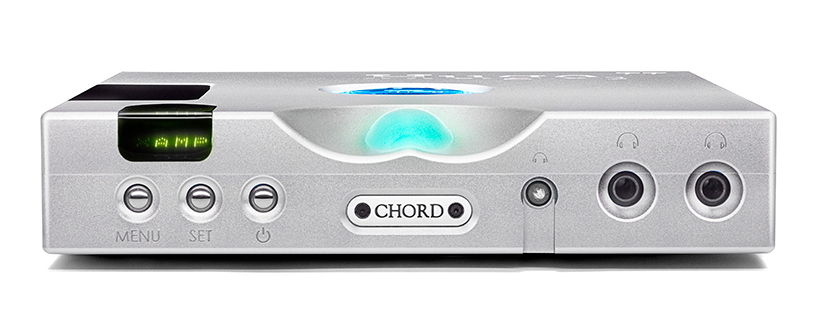
Crossfeed
TT 2 retains the very popular digital crossfeed provision of its predecessor. Crossfeed delays and mixes a small part of the right channel signal into the left channel and vice versa in an attempt to make headphone listening more akin to loudspeakers and reduce listening fatigue. Four settings are provided, ranging from no crossfeed (‘XFD0’) to a broad crossfeed (‘XFD3’), and are cycled using either the push buttons on the unit itself or the dedicated Crossfeed button on the remote.
Chord’s crossfeed implementation is probably the best of those I have auditioned and strikes a good balance between simplicity and adjustability. It is subtle enough not to interfere with the fabric of the music, but its effectiveness at alleviating listener fatigue is evident as soon as the facility is bypassed, causing reappearance of the somewhat unnatural and mildly disorienting sensation of hard-split left and right channels. As a seasoned headphone user I found the lowest setting (‘XFD1’) sufficient for most content, but I suspect the higher settings would be preferable to listeners more used to a loudspeaker presentation. Interestingly, the crossfeed is also available when Hugo is in DAC or preamp mode and can therefore be applied to speaker setups. This may be useful when circumstances dictate that the speakers are closer to the listening position and more widely spaced apart than is considered optimal.
Filters
TT 2 includes the four user-selectable noise-shaping filters that also feature in the portable Hugo 2. These can again be toggled using the unit’s push buttons or the Filter button on the remote. FIL1, described as ‘Incisive Neutral’, is the default and most transparent of the four settings. FIL3, called ‘Warm’, imparts a subtle warming tonality and may be useful when listening to recordings or headphones that exhibit a more strident high frequency balance. FIL2 and FIL4 apply a supersonic filter to FIL1 and FIL3 respectively to remove unwanted high frequency noise from high resolution recordings with sampling rates of 88.2kHz and above to prevent intermodulation distortion. This is particularly beneficial when playing DSD which has an inherently rising noise floor at such frequencies.
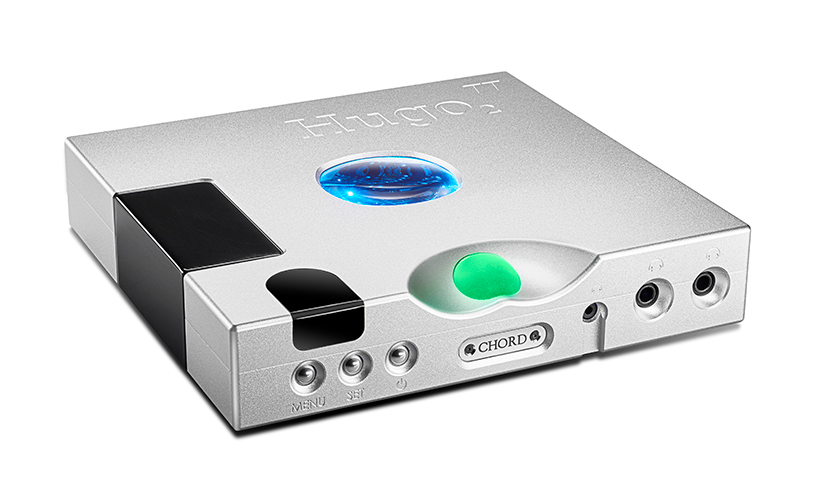
In practice, the sonic differences between the four filters are marginal, though I generally preferred the unadulterated crispness of FIL1 on most content. For DSD and high res recordings of questionable origin I engaged FIL2 mainly for peace of mind. With FIL3 or FIL4 engaged I detected a very slightsoftening of leading edges that was most noticeable on content with dynamic high frequency transients, acoustic guitar fingerpicking being a good example.
Verdict
Hugo TT 2 establishes a whole new level of excellency for Chord Electronics’ Hugo range of DACs/headphone amps, and I’d be very surprised if anything else currently on the market equals it in the feature and performance departments at its price point. Throw game-changing Hugo M Scaler into the mix as well, however, and this formidable pairing holds its own against any top end system it’s pitted against.
Equipment used
Source/s: Mac Mini running Audirvana+ and iTunes
Headphone/s: Audio-Technica ATH-ADX5000, Beyerdynamic DT880, Focal Utopia, Sennheiser
HD600, Sennheiser HD800S
External amplifier/s: Yamaha A-S3000
Loudspeakers: Celestion Ditton 66, Tannoy Monitor Gold 12


